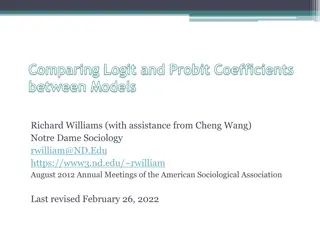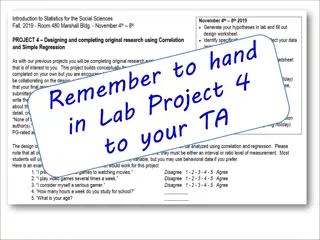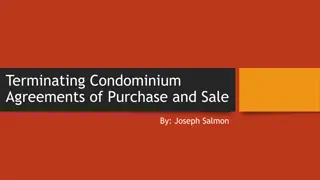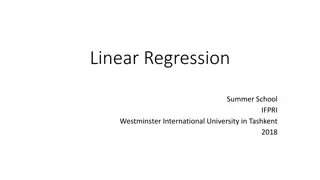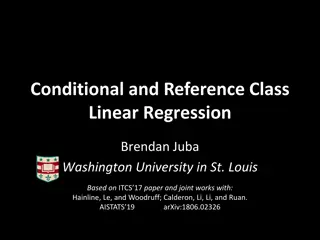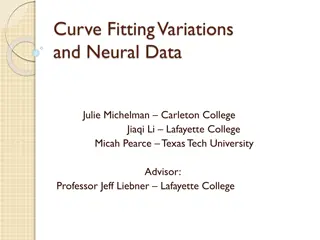Hedonic Regression Models for Tokyo Condominium Sales
This presentation delves into the application of Hedonic Regression Models for Tokyo condominium sales by Erwin Diewert from the University of British Columbia, as presented by Chihiro Shimizu from Nihon University. The content covers the background and motivation behind using residential property price indexes, the importance of decomposing the housing stock value, challenges in obtaining constant quality price components for unique housing units, and references to literature reviews in Asian countries related to housing market analysis.
Download Presentation

Please find below an Image/Link to download the presentation.
The content on the website is provided AS IS for your information and personal use only. It may not be sold, licensed, or shared on other websites without obtaining consent from the author.If you encounter any issues during the download, it is possible that the publisher has removed the file from their server.
You are allowed to download the files provided on this website for personal or commercial use, subject to the condition that they are used lawfully. All files are the property of their respective owners.
The content on the website is provided AS IS for your information and personal use only. It may not be sold, licensed, or shared on other websites without obtaining consent from the author.
E N D
Presentation Transcript
Hedonic Regression Models for Tokyo Condominium Sales by Erwin Diewert University of British Columbia (Presentation by Chihiro Shimizu, Nihon University) Hitotsubashi-RIETI International Workshop on Real Estate Market, Productivity, and Prices October 13-14, 2016 Research Institute of Economy, Trade and Industry 1-3-1 Kasumigaseki Chiyoda-ku Tokyo, JAPAN 2
Background and Motivation (1) Handbook on Residential Property Price Indexes from OECD, UN, IMF, BIS, World Bank from EuroStat (2013). Fenwick (2006): As a general macroeconomic indicator (of inflation); As an input into the measurement of consumer price inflation;As an element in the calculation of household (real) wealth As a direct input into an analysis of mortgage lender s exposure to risk of default. Shimizu, C., K. G. Nishimura and T. Watanabe (2010), Residential Rents and Price Rigidity: Micro Structure and Macro Consequences, Journal of Japanese and International Economy, 24, 282-299. 3
Background and Motivation (2) The International System of National Accounts asks countries to provide estimates for the value of assets held by the various sectors in the economy. These estimates are supposed to appear in the Balance Sheet Accounts of the country. An important asset for the Household Sector is the stock of housing. For many modeling purposes, it is important to not only have estimates for the value of the housing stock but to decompose the overall value into (additive) land and structure components and then to further decompose these value aggregates into constant quality price and quantity components. 4
Background and Motivation (3) This is not an easy task. When a housing property is sold, the selling price values the sum of the structure and land components and so a structure-land decomposition must be obtained by a modeling exercise. The problem of obtaining constant quality price components for the land and structure components of a housing unit is further complicated by the fact that housing units are almost always unique assets. A dwelling unit is different from any other dwelling unit at the same period in time due to its location, which is unique (and as locations vary for the same physical structure, the price of the land plot for the unit will generally change due to locational amenities). The same dwelling unit compared over space will also be different due to depreciation and possible renovations to the structure. 5
Literature Reviews In Asian countries, Shimizu, Nishimura and Watanabe (2010) compared Repeat Sales Indexes to Hedonic Indexes for Tokyo, while Deng, McMillen and Sing (2012) proposed a matching method for the Singapore housing market. Wu, Deng and Liu (2014) and Guo, Zheng, Geltner and Liu (2014) constructed price indexes for newly built houses in China. There are very few papers that construct quality adjusted price indexes for condominium sales which is our focus, along with providing a method to decompose property sales into land and structure components. Chapter 8 of Eurostat (2013), Diewert and Shimizu(2015) where a similar modeling strategy was applied to sales of detached dwellings. Builder s Model 6
Purposes The paper fits a hedonic regression model to the sales of condominium units in Tokyo over the period 2000-2015. Major Problems: The selling price of a condo unit has two main characteristics: (i) the floor space area of the unit and (ii) the unit s share of the land area of the building. But how exactly can we decompose the total property value into these two components? And how can we determine the unit s share of land value? Valuing a condo unit is a three dimensional problem; i.e., the height of the unit and the height of the building are important price determining characteristics. In general, constructing constant quality condominium price indexes is much more difficult than constructing house price indexes. 7
The Data (1) Our basic data set is on sales of condominium units located in the central area of Tokyo over the 61 quarters starting at the first quarter of 2000 and ending at the first quarter of 2015. There were a total of 3,232 observations (after range deletions) in our sample of sales of condo units in Tokyo. Tokyo Special District: Area: 626.70 km2 Population: 9,256,625 8
The Data (2) V = The value of the sale of the condo unit in 10,000 Yen; S = Structure area (floor space area) for the unit; TS = Floor space area for the entire building; TL = Lot area for the entire structure in units of meters squared; A = Age of the structure in years; H = The story of the unit; i.e., the height of the unit that was sold; TH = The total number of stories in the building; N = The number of units in the entire building; NB = Number of bedrooms in the unit; TW = Walking time in minutes to the nearest subway station; TT = Subway running time in minutes to the Tokyo station from the nearest station during the day (not early morning or night); SCR=Reinforced concrete construction dummy variable; SOUTH=Dummy variable. 9
The Data (3) In addition to the above variables, we also have information on which Ward of Tokyo the sales took place. We used this information to create ward dummy variables, DW,tn,j. Ward 1 = Sumida; Ward 2 = Koto; Ward 3 = Kita; Ward 4 = Arakawa; Ward 5 = Itabashi; Ward 6= Nerima; Ward 7 = Adachi; Ward 8 = Katsushika and Ward 9 = Edogawa. In order to reduce multicollinearity between the various independent variables listed above (and to achieve consistency with national accounts data), we assumed that the value of a new structure in any quarter is proportional to a Construction Cost Price Index for Tokyo. We denote the value of this index during quarter t as pSt. 10
The Basic Builder s Model (1) The builder s model for valuing a residential property postulates that the value of a residential property is the sum of two components: the value of the land which the structure sits on plus the value of the residential structure. The total cost of the property after the structure is completed will be equal to the floor space area of the structure, say S square meters, times the building cost per square meter, say, plus the cost of the land, which will be equal to the cost per square meter, say, times the area of the land site, L. (1) Vtn= tLtn+ tStn+ tn; t = 1,...,61; n = 1,...,N(t). 11
The Builders Model (2) For older structures, we modify eq (1) and allow for geometric depreciation of the structure: (2) Vtn= tLtn+ t(1 t)A(t,n)Stn+ tn; where the parameter treflects the net geometric depreciation rate as the structure ages one additional period and Ltnis the unit s share of the total land plot area of the structure (how do we determine this?), tis the price of land (per meter squared), t is the price of condo floor space (per meter squared), A(t,n) is the age of the structure in years and Stnis the floor space of the unit (in square meters). tis regarded as a net depreciation rate because it is equal to a true gross structure depreciation rate less an average renovations appreciation rate. (We do not have information on renovation expenditures). 12
Problems with the Builders Model There are at least two major problems with the hedonic regression model defined by (2): (i) The multicollinearity problem and (ii) The problem of imputing an appropriate share of the total land area to a particular condominium unit. Experience has shown that it is usually not possible to estimate sensible land and structure prices in a hedonic regression like that defined by (2) due to the multicollinearity between lot size and structure size. Thus we assume that the price of new structures is proportional to an official index of condominium building costs, pSt. Thus we replace tin (2) by pStfor t = 1,...,61. This reduces the number of free parameters in the model by 60. 13
The Land Share Imputation Problem There are two simple methods for constructing an appropriate land share: (i) Use the unit s share of floor space to total structure floor space or (ii) Simply use 1/N as the share where N is the total number of units in the building. Thus define the following two methods for making land imputations for unit n in period t: (3) LStn (Stn/TStn)TLtn; LNtn (1/Ntn)TLtn; t = 1,...,61; n = 1,...,N(t) where Stnis the floor space area of unit n in period t, TStnis the total building floor space area, TLtnis the total land area of the building and Ntnis the total number of units in the building for unit n sold in period t. The first method of land share imputation is used by the Japanese land tax authorities. The second method of imputation implicitly assumes that each unit can enjoy the use of the entire land area and so an equal share of land for each unit seems fair . 14
A Problem with the First Method of Imputation The shares Stn/TStn, if available for every unit in the building, would add up to a number less than one because the unit floor space areas, Stn, if summed over all units in the building, add up to privately owned floor space which is less than total building floor space TStn. Total building floor space includes halls, elevators, storage space, furnace rooms and other public floor space. An approximation to total building privately owned floor space for observation n in period t is NtnStn. Thus an imperfect estimate of the ratio of privately owned floor space to total floor space for unit n in period t is NtnStn/TStn. The sample wide average of these ratios was 0.899. Thus to account for shared structure space, we replaced the owned floor space variable in equation (2), Stn, by (1/0.899)Stn= (1.1)Stn. 15
Preliminary Regressions using the Two Methods for Making the Land Share Imputations In order to get preliminary land price estimates, we substituted the land estimates defined by (3) into the regression model (2), we replaced the tby pSt, the Stnby (1) Stnand we assumed that the annual geometric depreciation rate twas equal to 0.03. The resulting linear regression models become the models defined by (4) and (5) below: (4) Vtn= tLStn+(1.1) pSt(1 0.03)A(t,n)Stn + tn; (5) Vtn= tLNtn+(1.1) pSt(1 0.03)A(t,n)Stn+ tn. Thus we have 3,232 degrees of freedom to estimate 61 land price parameters tand one structure quality parameter for a total of 62 parameters for each of the models defined by (4) and (5). The R2for the models defined by (4) and (5) were only 0.5894 and 0.5863. 16
A Problem with Our Preliminary Regressions The estimates for were 2.164 and 2.154 respectively which was totally unsatisfactory because these parameters should have been close to unity. Moreover the land price indexes that these regression models generated were subject to excessive volatility (due to the very high estimates for the structure quality parameter, ). In order to deal with the problem of too high estimates of , we decided not to estimate it. Moreover, we temporarily put aside the problem of jointly determining land and structure value to concentrate on determining sensible constant quality land prices. Once sensible land prices have been determined, we will then return to the problem of simultaneously determining land and structure values and constant quality price indexes. 17
Imputed Land Value becomes our Dependent Variable In sections 4-10, we assumed that the structure value for unit n in period t, VStn, is defined as follows: (6) VStn (1.1)pSt(1 0.03)A(t,n)Stn; t = 1,...,61; n = 1,...,N(t). Once the imputed value of the structure has been defined by (6), we define the imputed land value for condo n in period t, VLtn, by subtracting the imputed structure value from the total value of the condo unit, which is Vtn: (7) VLtn Vtn VStn; t = 1,...,61; n = 1,...,N(t). Thus in the following 7 sections, we use VLtnas our dependent variable and we will attempt to explain variations in these imputed land values in terms of the property characteristics. However, in the end, we will return to using property value as the dependent variable and we will estimate the depreciation rate. 18
A Preliminary Land Value Regression For now, we will use the first land measure in (3) as our estimate of the share of total land that is imputed to unit n sold in period t; i.e., unit n s share of land in period t is measured as LStn= (Stn/TStn)TLtn. We will estimate the following preliminary linear regression model where imputed land value VLtnhas replaced total value Vtnas the dependent variable: (8) VLtn= tLStn+ tn; t = 1,...,61; n = 1,...,N(t). The above simple linear regression model has 61 land price parameters tto be estimated. The R2between the observed and predicted variables was only 0.0064 and the log likelihood was 25913.6. These results are hardly stellar but on a positive note, the resulting land price index was reasonably behaved. 19
The Introduction of Ward Dummy Variables In order to take into account possible neighbourhood effects on the price of land, we introduce ward dummy variables, DW,tn,j, into the hedonic regression (8). These 9 dummy variables are defined as follows: (9) DW,tn,j 1 if observation n in period t is in Ward j of Tokyo; 0 if observation n in period t is not in Ward j of Tokyo. We now modify the model defined by (8) to allow the level of land prices to differ across the 9 Wards. The new nonlinear regression model is the following one: (10) VLtn= t( j=19 jDW,tn,j)LStn+ tn. We need to impose at least one identifying normalization on the above parameters: (11) 1 1. The R2for this model turned out to be 0.1237 and the log likelihood (LL) was 25433.0, a big increase of 480.6 over the preliminary linear regression (8). 20
Building Height as an Explanatory Variable (1) It is likely that the height of the building increases the value of the land plot supporting the building, all else equal. In our sample of condo sales, the height of the building (the TH variable) ranged from 3 stories to 22 stories. However, there were very few observations for the last 7 height categories. Thus we collapsed the last seven height categories into a single category 14 and the remaining 13 height categories corresponded to building heights of 3 to 15 stories. Thus we define the building height dummy variables, DTH,tn,h, as follows: (12) DTH,tn,h 1 if observation n in period t is in building height category h; 0 if observation n in period t is not in building height category h. The new nonlinear regression model is the following one: 21
Building Height as an Explanatory Variable (2) (13) VLtn= t( j=19 jDW,tn,j)( h=114 hDTH,tn,h)LStn+ tn Comparing the models defined by equations (10) and (13), it can be seen that we have added an additional 14 building height parameters, 1,..., 14, to the model defined by (10). However, looking at (13), it can be seen that the 61 land price parameters (the t), the 9 ward parameters (the j) and the 14 building height parameters (the h) cannot all be identified. Thus we imposed normalizations on these parameters: (14) 1 1; 1 1. The R2for this model turned out to be 0.2849 and the log likelihood was 24831.8, a big increase of 601.2 over the LL of the model defined by (10) for the addition of 13 new parameters. Thus the height of the building is a very significant determinant of Tokyo condominium land prices. the following identifying 22
The Height of the Unit as an Explanatory Variable The higher up a unit is, the better is the view on average and so we would expect the price of the unit would increase all else equal. The quality of the structure probably does not increase as the height of the unit increases so it seems reasonable to impute the height premium as an adjustment to the land price component of the unit. Thus the new nonlinear regression model is the following one (the previous normalizations (15) were also imposed): (15) VLtn= t( j=19 jDW,tn,j)( h=114 hDTH,tn,h)(1+ (Htn 3))LStn + tn. The estimated value for turned out to be *= 0.0225 (t = 6.44). Thus the imputed land value of a unit increases by 2.25% for each story above the threshold level of 3. (LL increase was 26) 23
A More General Method of Land Imputation We set the land imputation for unit n in period t, Ltn, equal to a weighted average of the two imputation methods and estimate the best fitting weight, . Thus we define: (16) Ltn( ) = [ (Stn/TStn) + (1 )(1/Ntn)]TLtn The new nonlinear regression model is the following one: (17) VLtn= t( j=19 jDW,tn,j)( h=114 hDTH,tn,h)(1+ (Htn 3))Ltn( ) + tn; The R2was 0.3021 and the LL was 24644.8, a big increase of 161.0 over the previous model for the addition of one new parameter. The estimated was *= 0.3636 (t = 9.84) which is the weight for the floor space allocation method and the weight for the number of units in the building was 0.6364. 24
The Number of Units in the Building as an Explanatory Variable Conditional on the land area of the building, we expect the sold unit s land imputation value to increase as the number of units in the building increases. The range of the number of units in the building, Ntn, in our sample was from 11 to 154 units. Thus we introduce the term 1+ (Ntn 11) as an explanatory term in the nonlinear regression. The new parameter is the percentage increase in the unit s imputed value of land as the number of units in the building grows by one unit. The new nonlinear regression model is the following one: (18) VLtn= t( j=19 jDW,tn,j)( h=114 hDTH,tn,h)(1+ (Htn 3)) (1+ (Ntn 11))Ltn( ) + tn. The R2for this model was 0.3081 and the LL was 24604.4, a substantial increase of 40.4 over the previous model. 25
Subway Travel Times and Facing South as Explanatory Variables (1) There are three additional explanatory variables in our data set that may affect the price of land. Recall that TW was defined as walking time in minutes to the nearest subway station; TT as the subway running time in minutes to the Tokyo station from the nearest station and the SOUTH dummy variable is equal to 1 if the unit faces south and 0 otherwise. Let DS,tn,2equal the SOUTH dummy variable for sale n in quarter t. Define DS,tn,2= 1 DS,tn,1. TW ranges from 1 to 19 minutes while TT ranges from 12 to 48 minutes. These new variables are inserted into the nonlinear regression model (21) in the following manner: 26
Subway Travel Times and Facing South as Explanatory Variables (2) (23) VLtn= t( j=19 jDW,tn,j)( h=114 hDTH,tn,h)( m=110 mDEL,tn,m) ( 1DS,tn,1+ 2DS,tn,2)(1+ (Htn 3))(1+ (Ntn 11)) (1+ (TWtn 1))(1+ (TTtn 12))Ltn( ) + tn; (24) 1 1; 1 1; 1 1; 1 1. The R2for this model turned out to be 0.6308 and the log likelihood was 23178.30, a huge increase of 405.8 over the LL of the previous model for the addition of 3 new parameters. The estimated facing south parameter is 2*= 1.0294 (t = 120.6) so the land value of a condo unit that faces south increases by 2.94%. The walking to the subway parameter turns out to be *= 0.0176 (t = 26.7) so that an extra minute of walking time reduces the land value component of the condo by 1.76%. The travel time to the Tokyo Central Station parameter is *= 0.0128 (t = 27.4) so that an extra minute of travel time reduces the land value component of the condo by 1.28%. These are reasonable numbers. 27
Using the Selling Price as the Dependent Variable We switch from imputed land value VLtnas the dependent variable in the regressions to the selling price of the property, Vtn. We introduced the number of bedrooms variable, NBtn, and the reinforced concrete construction SCRntdummy variable as quality adjusters for the value of the structure. The details are omitted. (26) Vtn= t( j=19 jDW,tn,j)( h=114 hDTH,tn,h)( m=110 mDEL,tn,m) ( 1DS,tn,1+ 2DS,tn,2)(1+ (Htn 3))(1+ (Ntn 11)) (1+ (TWtn 1))(1+ (TTtn 12))Ltn( ) + (1.1)pSt(1 )A(t,n)(1+ SRCtn)( i=13 iDB,tn,i)Stn + tn; Basically, we now estimate the depreciation rate instead of assuming that it equals 3%. The R2for this new model turned out to be 0.8190 and the log likelihood was 23164.33. (Not comparable with (21) LL). The estimated depreciation rate was *= 0.0367 (t = 27.1). This estimated annual depreciation rate of 3.67% is higher than our earlier assumed rate of 3.00%. 28
Land, Structure and Property Price Indexes pLt, pStand pt for the Section 12 Model and Land and Property Price Indexes pLt*and pt*for the Section 13 Model 1.5 1.4 1.3 1.2 1.1 1 0.9 0.8 0.7 pL pS p pL* p* 29
Comparison of the Section 12 Price Index with other Condo Price Indexes (1) The price indexes for land, structures and the entire property on the previous slide were for sales of condo units. But for national accounts purposes, we need in particular, an index for the stock of land used to support condo units. We can form an approximation to the stock of condo units in our 9 wards by summing over all the units sold during the 61 periods in our sample; i.e., we replace sales weights by approximate stock weights. The resulting land and overall price indexes are Lowe indexes and they were very close to our Sales price index counterparts. The Overall Section 12 Sales Price Index pt, the Lowe Index pLOWEt, a Traditional Time Dummy Hedonic Regression Sales Price Index pTDtand the Quarterly Mean and Median Price Indexes of Sales, pMEANt and pMEDt, are shown in the following figure. 30
Comparison of the Section 12 Price Index with other Condo Price Indexes (2) 1.5 1.4 1.3 1.2 1.1 1 0.9 0.8 0.7 2002Q2 2015Q1 2000Q1 2000Q4 2001Q3 2003Q1 2003Q4 2004Q3 2005Q2 2006Q1 2006Q4 2007Q3 2008Q2 2009Q1 2009Q4 2010Q3 2011Q2 2012Q1 2012Q4 2013Q3 2014Q2 P PLOWE PTD PMEAN PMED 31
Conclusion Our nonlinear regression approach led to an estimated geometric depreciation rate for Tokyo apartment buildings of about 3.6% per year, which seems reasonable. (1.68% from Traditional Time dummy hedonic.) Our preferred overall price index for condo sales was virtually identical to the corresponding Lowe index which provides an approximation to a price index for the stock of condo units in Tokyo. Means and median indexes of condo sales tend to have a downward bias due to their neglect of net depreciation of the structure. Traditional time dummy hedonic regressions can generate reasonable overall price indexes for condo sales. However, if the estimated age coefficient is large and positive, the resulting time dummy price index is likely to have a substantial downward bias. Our method does lead to a reasonable decomposition of condo property prices into land and structure components. 32
Our Future Works New estimation method for Transaction Based Commercial Property Price Indexes. 33











